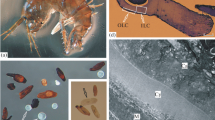Abstract
-
1.
A spirochete which occurs in tissues of the brine shrimp,Artemia salina, was studied by light microscopy and transmission electron microscopy. A total of seven infected shrimps were encountered.
-
2.
Under darkfield illumination, most spirochete cells inArtemia blood were 6–13 μ long and 0.3–0.4 μ wide. Coiling was variable and often irregular.
-
3.
When tissues of the maxillary gland (kidney) and nearby organs were examined by electron microscopy, spirochete cells were found in both extracellular and intracellular locations. These microbes possessed the ultrastructural features typical of members of the Order Spirochaetales: a) a slender protoplasmic cylinder (0.18 μ average diameter), b) axial fibrils (150 A average diameter), and c) an outer envelope or sheath (approximately 75 A thick).
-
4.
Counts made of the number of axial fibrils evident in transverse sections of spirochete cells were consistent with the hypothesis that this spirochete has a 1-2-1 arrangement of axial fibrils.
-
5.
Non-spiral forms were observed in the haemocoel and in the lumen of the maxillary gland.
Similar content being viewed by others
References
Auran, N. E., Johnson, R. C., Ritzi, D. M.: Isolation of the outer sheath ofLeptospira and its immunogenic properties in hamsters. Infect. and Immun.5, 968–975 (1972)
Bharier, M. A., Rittenberg, S. C.: Chemistry of axial filaments ofTreponema zuelzerae. J. Bact.105, 422–429 (1971)
Breznak, J. A., Canale-Parola, E.:Spirochaeta aurantia, a pigmented, facultatively anaerobic spirochete. J. Bact.97, 386–395 (1969)
Canale-Parola, E., Holt, S. C., Udris, Z.: Isolation of free-living, anaerobic spirochetes. Arch. Mikrobiol.59, 41–48 (1967)
Czekalowski, J. W., Eaves, G.: Formation of granular structures by leptospirae as revealed by the electron microscope. J. Bact.67, 619–627 (1954)
DeLamater, E. D., Haanes, M., Wiggall, R. H.: Studies on the life cycle of spirochetes. V. The life cycle of the Nichols nonpathogenicTreponema pallidum in culture. Amer. J. Syph.35, 164–179 (1951a)
DeLamater, E. D., Haanes, M., Wiggall, R. H.: Studies on the life cycle of spirochetes. VII. The life cycle of the Kazan nonpathogenicTreponema pallidum in culture. Amer. J. Syph.35, 216–224 (1951b)
DeLamater, E. D., Wiggall, R. H., Haanes, M.: Studies on the life cycle of spirochetes. III. The life cycle of the Nichols pathogenicTreponema pallidum in the rabbit testis as seen by phase contrast microscopy. J. exp. Med.92, 239–246 (1950)
Hampp, E. G., Scott, D. B., Wyckoff, R. W. G.: Morphologic characteristics of certain cultured strains of oral spirochetes andTreponema pallidum as revealed by the electron microscope. J. Bact.56, 755–769 (1948)
Hardy, P. H., Nell, E. E.: Influence of osmotic pressure on the morphology of the Reiter treponeme. J. Bact.82, 967–978 (1961)
Hespell, R. B., Canale-Parola, E.:Spirochaeta litoralis sp.n., a strictly anaerobic marine spirochete. Arch. Mikrobiol.74, 1–18 (1970)
Holt, S. C., Canale-Parola, E.: Fine structure ofSpirochaeta stenostrepta, a free-living, anaerobic spirochete. J. Bact.96, 822–835 (1968)
Hougen, K. H., Further observations on the ultrastructure ofTreponema pallidum Nichols. Acta path. microbiol. scand. B.80, 297–304 (1972)
Hougen, K. H., Birch-Andersen, A.: Electron microscopy of endoflagella and microtubules inTreponema Reiter. Acta path. microbiol. scand. B79, 37–50 (1971)
Jackson, S., Black, S. H.: Ultrastructure ofTreponema pallidum Nichols following lysis by physical and chemical methods. II. Axial filaments. Arch. Mikrobiol.76, 325–340 (1971)
Joseph, R., Canale-Parola, E.: Axial fibrils of anaerobic spirochetes: ultrastructure and chemical characteristics. Arch. Mikrobiol.81, 146–168 (1972)
Listgarten, M. A., Socransky, S. S.: Electron microscopy of axial fibrils, outer envelope and cell division of certain oral spirochetes. J. Bact.88, 1087–1103 (1964)
Listgarten, M. A., Socransky, S. S.: Electron microscopy as an aid in the taxonomic differentiation of oral spirochetes. Arch. oral. Biol.10, 127–138 (1965)
Nauman, R. K., Holt, S. C., Cox, C. D.: Purification, ultrastructure, and composition of axial filaments fromLeptospira. J. Bact.98, 264–280 (1969)
Ovcinnikov, N. M., Delectorskij, V. V.: Further study of ultrathin sections ofTreponema pallidum under the electron microscope. Brit. J. vener. Dis.44, 1–34 (1968)
Ovcinnikov, N. M., Delektorskij, V. V.: Further studies of the morphology ofTreponema pallidum under the electron microscope. Brit. J. vener. Dis.45, 87–116 (1969)
Pillot, J., Dupouey, P., Ryter, A.: La signification des formes atypiques et la notion de cycle évolutif chez les spirochètes. Première partie. Ann. Inst. Pasteur107, 484–502 (1964a)
Pillot, J., Dupouey, P., Ryter, A.: La signification des formes atypiques et la notion de cycle évolutif chez les spirochètes. Deuxième partie. Ann. Inst. Pasteur107, 663–677 (1964b)
Ritchie, A. E., Ellinghausen, H. C.: Electron microscopy of leptospires. I. Anatomical features ofLeptospira pomona. J. Bact.89, 223–233 (1965)
Rodrigues, M. M.: Cell-wall defective variants ofTreponema pallidum. Brit. J. vener. Dis.49, 227–238 (1973)
Smibert, R. M.: Spirochaetales, a review. CRC Crit. Rev. Microbiol.2, 491–552 (1973)
Swain, R. H. A.: Electron microscopic studies of the morphology of pathogenic spirochaetes. J. Path. Bact.69, 117–128 (1955)
Tyson, G. E.: The fine structure of the maxillary gland of the brine shrimp,Artemia salina: The end-sac. Z. Zellforsch.86, 129–138 (1968)
Tyson, G. E.: The fine structure of the maxillary gland of the brine shrimp,Artemia salina: The efferent duct. Z. Zellforsch.93, 151–163 (1969a)
Tyson, G. E.: Intercoil connections of the kidney of the brine shrimp,Artemia salina. Z. Zellforsch.100, 54–59 (1969b)
Tyson, G. E.: The occurrence of a spirochete-like organism in tissues of the brine shrimpArtemia salina. J. Invert. Path.15, 145–147 (1970)
Tyson, G. E.: A distinctive renal lesion of spirochete-infected brine shrimp. J. Bact. (in press, 1974)
Author information
Authors and Affiliations
Rights and permissions
About this article
Cite this article
Tyson, G.E. Ultrastructure of a spirochete found in tissues of the brine shrimp,Artemia salina . Arch. Microbiol. 99, 281–294 (1974). https://doi.org/10.1007/BF00696243
Received:
Issue Date:
DOI: https://doi.org/10.1007/BF00696243




